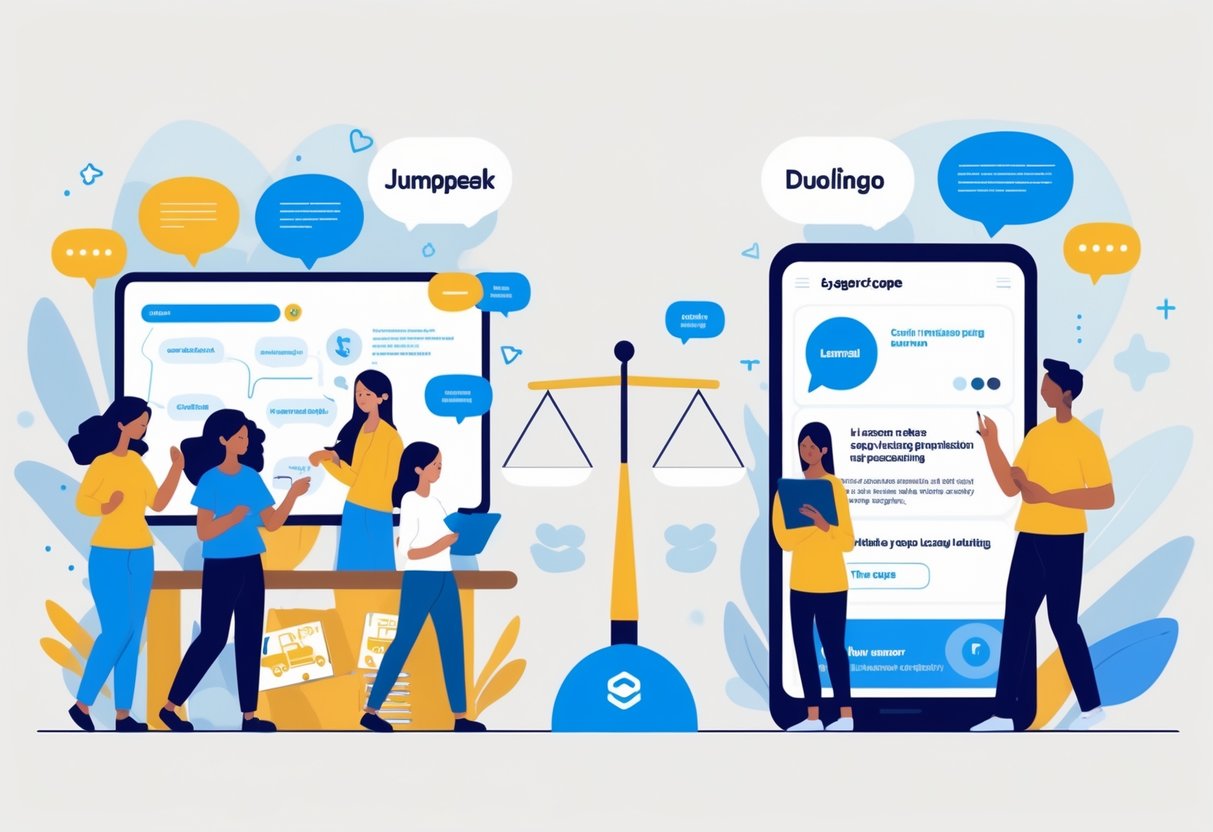Learning a new language isn’t easy, but the right app can make all the difference. Jumpspeak and Duolingo are both popular, yet their approaches couldn’t be more different.
Jumpspeak puts conversation and speaking skills front and center. Duolingo leans into vocabulary building with its signature game-like lessons.
Are you aiming to chat confidently, or do you want a solid base in reading and writing? That’s really what your choice boils down to.
Millions use both apps, but they cater to different learning styles and personalities. Knowing what sets them apart can help you figure out which one fits your goals.
Key Takeaways
- Jumpspeak goes all-in on speaking, while Duolingo covers a broader range of language skills with games
- Your goals should steer your choice between the two
- Each platform brings something unique, depending on how you like to learn
Core Differences Between Jumpspeak and Duolingo

Jumpspeak leans heavily into AI-driven conversations and speaking drills. Duolingo, on the other hand, gamifies everything—reading, writing, listening, and some speaking—across bite-sized lessons.
Teaching Methodologies and Focus
Jumpspeak’s whole thing is conversation-based learning. From your first session, you’re chatting with an AI tutor that actually listens and corrects your pronunciation on the spot.
Duolingo keeps it more classic. You move through structured lessons that hit vocabulary, grammar, reading, and writing. Speaking comes in later, once you’ve leveled up a bit.
Jumpspeak’s method:
- Jump right into conversations
- Instant AI pronunciation feedback
- Fluency comes first, not grammar drills
Duolingo’s method:
- Build skills step by step
- Plenty of multiple choice and fill-in-the-blank
- Balanced focus across all language skills
Speaking Practice Features
Jumpspeak makes speaking its main event. You get unlimited chats with AI tutors on all sorts of topics, and the AI actually responds in a pretty natural way.
Your sessions get analyzed for pronunciation, fluency, and accuracy. The app spits out feedback right away and nudges you to fix any awkward sounds or phrasing.
Duolingo does have speaking exercises. You’ll repeat phrases, answer a few questions aloud, and work on pronunciation here and there.
But honestly, speaking is a small slice of the Duolingo pie. Most of the time, you’re reading sentences aloud or answering quick oral prompts, not having real conversations.
Gamification and Motivation Strategies
Duolingo is all about gamification. You rack up XP points, chase daily streaks, climb leagues, and unlock badges. The app loves to remind you to log in, sometimes a little too much.
Your progress shows up on a colorful map, with skill trees to conquer. There are stories and extra practice sessions, so it doesn’t get too repetitive.
Jumpspeak, though, doesn’t make a big deal out of gamification. You stay motivated by seeing your own real-world improvement—like actually being able to hold a conversation.
Instead of badges, you get to watch your fluency improve. The app keeps track of your speaking progress, not just your lesson completions.
Learning Outcomes and User Experience
JumpSpeak is all about speaking practice and uses advanced speech recognition. Duolingo, meanwhile, spreads its focus and keeps you coming back with gamified streaks. Both apps track your progress, but in pretty different ways.
Speech Recognition and Feedback
JumpSpeak’s speech recognition is pretty advanced. As you speak, it analyzes your pronunciation in real-time and gives you instant feedback—sometimes a little too honest, but that’s how you learn.
You can keep repeating exercises until you nail the pronunciation. The feedback is specific, so you know exactly where you’re tripping up.
Duolingo also has speech recognition, but it’s less detailed. You can even turn off speaking exercises if you want.
The feedback is simpler: basically, it tells you if you got it right or wrong. Don’t expect a breakdown of your accent or anything fancy.
If you’re serious about speaking, JumpSpeak’s recognition is just better. Duolingo’s tool is fine for basics, but it won’t catch every slip-up.
Vocabulary and Grammar Coverage
Duolingo covers a lot of ground—more grammar, more vocabulary. You’ll practice sentence structure, verb tenses, and all sorts of grammar patterns with a variety of exercises.
Vocabulary comes at you from all angles: reading, writing, listening, and speaking. You see new words in different contexts, which helps them stick.
JumpSpeak keeps it practical. You’ll pick up conversational vocabulary and phrases you actually need to speak, but don’t expect deep dives into grammar rules.
You learn by speaking, not by drilling grammar charts. It’s about sounding natural in conversation, not acing a written test.
Duolingo gives you a wider vocabulary and more grammar. JumpSpeak sticks to the essentials you need for real-life chats.
Progress Tracking and Daily Streaks
Duolingo keeps you coming back with daily streaks. The streak counter becomes weirdly addictive—miss a day, and you’ll probably feel a twinge of guilt.
The app pings you if you’re about to lose your streak. You can even freeze it with gems if you’re busy.
JumpSpeak tracks your progress differently. It measures your speaking time, which skills you’ve improved, and the conversation topics you’ve tackled.
Your progress is more about completed conversations and pronunciation scores. There’s no streak to maintain, which might be a relief for some folks.
Both apps show how much you’ve learned, but in their own way. Duolingo uses points and streaks; JumpSpeak highlights your speaking growth.
Frequently Asked Questions

Jumpspeak and Duolingo take pretty different paths to teaching languages. Jumpspeak is all about speaking practice, while Duolingo gamifies the whole learning process. The cost and language selection also vary quite a bit.
What are the differences in teaching methodologies between Jumpspeak and Duolingo?
Jumpspeak is built around conversational practice, using AI-powered speaking exercises. You jump into realistic dialogues right away and get instant feedback on pronunciation and fluency. Speech recognition analyzes your responses, so you’re practicing real conversations from day one—not slogging through grammar drills first. Duolingo gives you a mix of reading, writing, listening, and speaking.
Lessons are bite-sized, and new vocab or grammar rules show up gradually. Spaced repetition helps you remember stuff, and you rack up points, streaks, and levels as you go. It’s a bit like a game, just with more verbs.
How does the cost of Jumpspeak compare to a Duolingo subscription?
Jumpspeak charges $19.99 a month, or $119.99 for a year. That gets you unlimited access to all speaking exercises and every language they offer. You also get feedback on your pronunciation and conversation skills, plus some progress tracking and adaptive features.
Duolingo Plus is cheaper—$6.99 per month, or $83.99 for the year. There’s a free version, too, but you’ll see ads and have a few limits. With Plus, you lose the ads, get offline lessons, unlimited hearts, and more progress tracking. Either way, you can try all the languages they have.
Which platform, Jumpspeak or Duolingo, offers more language options for learners?
Duolingo has over 40 languages for English speakers. The big ones are there—Spanish, French, German, Italian, Portuguese, Japanese—you name it. There are even some quirky ones, like Welsh, Irish, and even Klingon. They keep adding new languages, so the list keeps growing. Jumpspeak sticks to the heavy hitters: Spanish, French, German, Italian, and Portuguese.
They focus on depth, not breadth. So, you’ll get more intense speaking practice, but only in a handful of languages. If you want to dabble in something obscure, Duolingo’s your best bet.
Can Jumpspeak’s conversational focus provide a more immersive learning experience than Duolingo?
Jumpspeak drops you into immersive scenarios right away, so you’re practicing speaking from the start. Its AI listens to how you talk and tweaks the difficulty as you go, which feels pretty dynamic. You get to have realistic conversations—ordering food, asking for directions, that sort of thing. The whole platform leans hard into practical communication, not just memorizing grammar rules.
Duolingo, on the other hand, leans into immersion with all sorts of exercise types and some storytelling thrown in. You bump into the language from all angles: visual, audio, and writing. There are podcast-style lessons and short stories, especially if you’re past the basics. So, you kind of build up immersion little by little, just by sticking with it every day.

